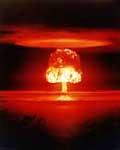 "The effects could well be called unprecedented, magnificent, beautiful, stupendous, and terrifying. No man-made phenomenon of such tremendous power had ever occurred before. The lighting effects beggared description. The whole country was lighted by a searing light with the intensity many times that of the midday sun."
"The effects could well be called unprecedented, magnificent, beautiful, stupendous, and terrifying. No man-made phenomenon of such tremendous power had ever occurred before. The lighting effects beggared description. The whole country was lighted by a searing light with the intensity many times that of the midday sun."Eyewitness Account of the Trinity Test
We have all lived in the long and terrifying shadow of the mushroom cloud for over half a century now. Some days you forget about "The Bomb" and on others the fear crawls out of the back of your mind and screams in your face. There is something strangely attractive about nuclear weapons. Is it the sheer power of these hideous devices that can be so enchanting? The mushroom cloud itself is an icon of a terror and destruction that is almost beyond imagination. It is the motif, along with the concentration camp and the starving child, that defines the twentieth century. It is the signpost that guides us to oblivion.
There we're two occasions in the Twentieth Century when the world was close to all out nuclear war. The first and most famous was the Cuban Missile Crisis of 1962 and the second and less well know was in 1983 around the time that the Reagan administration announced it's plans to develop the anti-missile Strategic Defence Initiative that became know, rather comically, as "Star Wars".
The Russians we're so convinced that the United States and it's allies were preparing for a nuclear attack against the Soviet Union that the then head of the KGB, Yuri Andropov, organised the Soviet military along with the KGB and the GRU for a campaign of global espionage, code-named RYAN, which was the Russian acronym for "nuclear missile attack" . This, primarily, was a heightened state of intelligence alert, instructing all foreign stations to conduct a constant watch for tell-tale signs of the build up to a Western nuclear strike. This meant hours of watching government buildings, noting the number of cars arriving and leaving, counting the number of lighted offices after normal working hours and generally looking for any signs of unusual activity. Tensions grew to fever pitch when on September 1st 1983
Soviet fighter jets shot down a Korean Airlines 747. The west was quick to condemn the attack on a civilian plane but the Russians claimed that it was on an espionage mission in Soviet airspace.
We don't have to guess what the effects of a nuclear war would be. We have had two very famous examples of the results that could be expected from Hiroshima and Nagasaki. If we add to those two tragedies the meltdown and subsequent explosions at Three mile Island and Chernobyl and the data collected from them we can get a very clear idea of the long term horror and suffering that an atomic war would engender. So thank the Gods that they've never really been used. Well that's a lie. "The Bomb" has been dropped, officially, at least 2,050 times between 1945 and 1998. 528 of these explosions were atmospheric detonations and the other 1,522 were carried out underground. These 'tests' have been carried out on every continent in the world. It's probably impossible to realistically estimate what the effects of this testing policy has been and what long term changes to our environment could follow but there have already been numerous scientific studies linking atomic testing to an increase in earthquake activity.
The costs of the nuclear program are astronomical. So far the total expense is estimated to be somewhere in the region of $5.8 trillion. Even after the collapse of the Soviet Union the United States is still spending $35 billion a year ($96 million per day) on its nuclear weapons. About $25 million per day goes on operation and maintenance and the rest is spent on ballistic missile defence research (the United States announced its withdrawal from the ABM treaty on the 14th of December 2001). The United States with all it's rhetoric about "rogue states" and "WMDs" is still the only nation on the face of the planet that is researching new ways in which to deploy nuclear warheads. As I'm writing this the United States is developing a new breed of "Bunker Buster" nuclear missiles for use in "conventional" warfare.
And all of this takes place in a world where 1.3 billion people live on less than one dollar a day; 3 billion live on under two dollars a day; 1.3 billion have no access to clean water; 3 billion have no access to sanitation; 2 billion have no access to electricity... It's not rocket science is it?
No comments:
Post a Comment